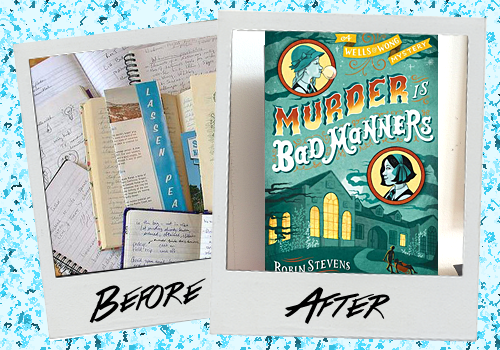Why the Most Important Thing About Your Novel Is the Story, Not the Words

The “Now What?” Months are here to guide you through the editing, revision, and publishing processes! Every novel is the “after” picture to the first draft’s “before”. Today, Robin Stevens, Wrimo and author of the forthcoming Murder is Bad Manners , shares how she discovered what really matters to her novel:
The first draft: I won NaNoWriMo 2011 by the skin of my teeth. By the 30th of November my draft was 50,025 words and unfinished (it stopped in the middle of a sentence, and the murderer was not revealed). It was so much looser and more ugly than anything I’d produced before, and I panicked. I closed down the document in horror and simply pretended that it didn’t exist.
But I kept being itched at by that unfinished book. I needed to get the ending out of my head, and that meant going back and looking at the tangled pile of story that was already there. I didn’t know how to tackle an edit—it wasn’t anything I’d ever really done before—but then a friend gave me some advice…
"Don’t work from that old document," she said. "Create a new one, put the old one next to it and transfer the good stuff over."
The makeover: What she meant, it emerged later, was to work on a split screen, but what I actually did in early 2012 was to print out my existing story and then type up the whole thing again, not just editing but rewriting, deleting anything that didn’t seem to fit with the new draft.
This was a bit extreme, but it was also the beginning of an editing lesson that I’m still learning the importance of three years and three books later: what matters is the story. The words you use to tell it are just words. They might be nice words, they might be really beautiful words, but if they don’t help your story move forward, they need to be deleted. If you wrote them once, you know that you can write something equally good, or even better, again.
Remember that your NaNo draft is your first draft, and you should treat it not as a finished product but as a jumping-off point. In the months after NaNo, you’ve had time to really think about your story, and when you come to rewrite (as lots of you are doing now) you can give depth to your characters, tighten the loose parts, connect the dots and hone it into the lean, exciting book that’s hiding under your confusing first draft.
I’ve also discovered that good editing is collaborative. It’s important to take on board criticism from readers, whether they are agents, editors, fellow writers or your family. If something doesn’t work for a reader, it probably does need fixing. But don’t be upset, just step back and wonder why they picked up on that issue. Being a writer is a bit like being a story mechanic—only you can solve your own story, and I think that’s one of the most exciting things about being an author.
The final product: The most important thing I learned is not to worry about what’s in front of you right now. My NaNo novel, A Most Unladylike Murder (now published as Murder Most Unladylike in the UK in 2014 and Murder is Bad Manners in the US in April 2015), went through four more drafts after that first rewrite. My next book, Arsenic for Tea, published in the UK in January 2015, also went through four. So you don’t have to get it right first time—or even second, or third. You just have to get closer.
Remember this: your brain is amazing. That’s why you wrote a book. Have faith in that amazing brain. If it came up with something great a few months ago, who knows what it can do now? You’ll only find out if you try. Good luck, brave NaNo editors! The real fun starts here.

Robin Stevens was born in California and grew up in an Oxford college, across the road from the house where Alice in Wonderland lived. She has been making up stories all her life. She now works at a children’s publisher, which is pretty much the best day job she can imagine. Robin lives in Cambridge, England, with her boyfriend and her pet bearded dragon, Watson.
Chris Baty's Blog
- Chris Baty's profile
- 63 followers



